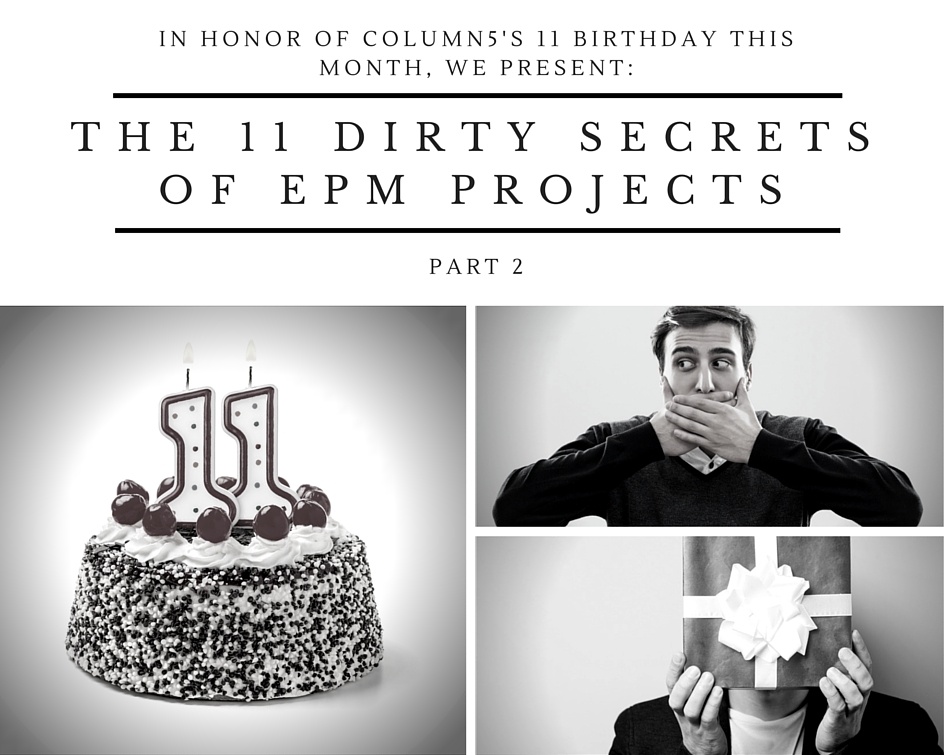
This is the second part of the original post of 11 Dirty Secrets of EPM Projects.
"I thought for Column5's 11th birthday, I'd give our more than 1000 blog readers a gift! I’ve wrapped it up and called in the 11 'dirty secrets' of EPM projects. I know this is heresy to disclose some of these EPM professional services insider secrets, but I care more about you being successful than I worry about the flak I will inevitably get by letting you in on these secrets."
Let’s continue:
Dirty Secret #6: Systems inadvertently create dependency on 3rd party
This one perplexes me as to how customers could be persuaded to accept this situation. Every single customer I meet with seems to say, “We don’t want to be relying on consultants forever.” But very often, I watch as the customer falls into traps where they create the opposite situation because they do not know how to avoid it.
Here’s a litmus test:
- Are you unable to manage, change, or even operate the system independently without engaging your service provider?
- Do you feel your EPM solution is a “blackbox”?
- Do you trust anyone but the author to touch it?
If any of these feel familiar, you very likely have a problem. Inevitably, your provider resources won't be available when you need them or when you do engage them, you’re spending a premium for them to perform a task. Instead of relying on the provider indefinitely, you should be asking whether this task is something your organization should be able to do. In many cases, someone with a broader perspective will come in and ask the question: “why are we relying on them for our success? Why are we paying so much for this?” Once this inefficiency is discovered the consultants are at risk as well as those who chose to hire them. No one thinks that this will happen to their organization, but you are at risk if the dependency is not foreseen or properly managed.
Consultants in this situation are riding the gravy train at your expense. Some providers figure that the more kept in the dark and incapable customers are, the better. That’s not to say this situation is intentionally malicious, but it is lucrative (for one party)! Being as generous as possible, the desire of the consultant to be perceived as helpful and useful, and how much the customer tends to rely on the consultant makes this desire turn into enabling. Enabling the customer to depend solely on the provider’s resources, not only makes consultants feel more useful, but makes money. 
The truth is, avoiding this situation takes planning and upfront resource allocation. Committing time of the internal personnel during the project to develop their skill level will produce much better and more cost efficient results over time. Here again, the obsession of price comparison rears its ugly head. Customers choosing a provider may view the higher costs of up front knowledge transfer and training, as “more expensive” than option B. In two to three years’ time however, the painfully high costs of dependency and ineffective afterthought training will make the original upfront cost much more preferable.
Dirty Secret #7: Lesser consultants rely on sympathy factor
This is more of a psychological challenge than a technical one. I have heard several clients that have been in dire straits tell me that "yes, our system still can't go live, BUT so and so is a great guy. He's so nice and he's working as hard as he can. He's really trying to make the best of a difficult situation, and the team really likes him." I'm going to risk coming across as an indifferent jerk here, but the frequency of this circumstance is alarmingly commonplace.
These rationalizations come from the consultant’s efforts to retain their role on the project in the face of failures or almost failures. They convince the customer, who has contracted services with them, to ignore the inefficiencies and unnerving observations in front of them and instead focus on comparably trivial qualities of the consultant as a person. Sure, he or she is failing you as a consultant but it’s gotta be outside of their control or some other explanation because gosh darn it you like them! In other words, the evidence indicates one thing: that this consultant you’ve hired doesn't know what they're doing, but sympathy clouds that painful judgement. This 'nice guy' veneer is designed to deflect much needed scrutiny of their work, and engender sympathy from your team.
Second litmus test:
- Are you and the provider missing deadlines?

- Are they having issues controlling the software or configuring it to be error free despite your contractual agreements?
- Are you are paying more than anticipated and don't know exactly why?
- Does it seem your service provider is spending more time bribing you with gifts, dinners, etc. than meeting their contractual obligations?
- Is your service provider taking responsibility for missteps or are they playing on your sympathies to forgive them?
- Does it seem that they’ve given you every excuse in the book for problems?
If you struggle with any of these above then this 'nice guy' is no true friend of yours. I have even seen some entire consulting firms that have this in their very DNA. They are quick to take a customer golfing, to a sports event, bring in candy or pastries in meetings, buy everyone coffee – all to woo the customer as much as possible. Perhaps the customers should ask, “why do they have a highly developed system of relationship building (bordering on bribery) so quickly?” They're relying on establishing this one way emotional affinity because they need this relationship to become sympathy when struggles happen. This kind of firm has cut corners by not investing to develop the proper skills or appropriate support structure to provide consistent high quality work. Perhaps, instead, those investment dollars were diverted to buy tickets, rounds of golf or other frivolities unrelated to customer success.
As their client, it will be you who will be paying the price for every mistake your consulting firm makes. Consultants who rely on this emotional approach have an alarmingly high coincidence of the typical underinvestment in their practice that inevitably impact your results. Maybe it will manifest as the diluted value of a solution that the trusting customer will view as just “OK”. I promise you the sympathy factor will be turned up to ‘11’ when anyone questions consultants like this about struggles. They will attempt to blur the lines of responsibility.
When asking whose fault a struggle is, do you think the answer should be 1. The software, 2. The client, or 3. The consultant who brought you to the big game? I'll cut to the chase and give you the answer - it's the consultant. Competent consultants make investments inthe skills and knowledge necessary to manage risks stemming from the client and technology, and still manage to get results. You'd be better off getting someone who doesn't focus on being your friend, but is focused on being a coolly efficient consultant that consistently delivers results. If a friendship develops, that’s a side benefit to an effective EPM solution.
Dirty Secret #8: Process excellence not benchmarked widely
So how could shoddy results for expensive EPM projects become so prevalent? Comparing your EPM process to other companies is a very difficult undertaking especially in diverse sizes and industries. Unlike the mechanic book in our last blog, there is no widely distributed report that discusses what excellence looks like in detail, much less what the step by step best practice process is to achieve this state. So if the destination (success) is hard to define, and the process (best practices) is a secret, is it any wonder very few customers arrive at a profitable result? It should be no surprise whatsoever.
What is Column5 doing about this? We are members of a prestigious organization that is focused on EPM excellence – EPM International. A major activity of this group is to conduct surveys and publish whitepapers that disclose what excellence looks like. This is a time consuming process that requires the investment of significant resources. Establishing a benchmark for what quantifies as ‘average’ so we can target above average results for our clients is an important objective for us. Other companies don’t even make an effort to quantify what a best in class process looks like. Savvy customers would do well to challenge their consultants:, “how do you know what a best practice is?” Often, the answer is that this provider does not really know. If by chance they do have some answer, it may not be backed by an empirical process involving scientific measurement and statistics. An answer of “Personal experience,” should set off the alarm bells that your project may already be at risk of not achieving a valuable solution that compares favorably to your competitors’ capabilities.
Dirty Secret #9: Products are often wrongly blamed

My grandfather told me: “A poor craftsman blames his tools.” When I hear people condemn their EPM product as inadequate, I think back to the expansive tool collection my grandpa accumulated over his lifetime. Each tool was maintained properly, meticulously hung in its prescribed location, and used with expert hands, established over a lifetime of craftsmanship. Even months before he passed away, he was still attending classes on small engine repair to hone the most important tool in his collection – his knowledge. I watched as cleaned and lubricated the physical tools after each use. I observed that he spent about half the total time of a project maintaining his tools, and about half the time actually using them. You could rely on the tool being in its proper place and working perfectly for its intended purpose when he reached for it in an emergency. I can’t imagine operating any other way as the CEO of a leading EPM consultancy. The same lessons I learned, as a child watching my grandpa, apply for EPM processes & tools. Learning how to properly use and maintain a tool will ensure a long life of reliability and value.
If my grandfather didn’t make the right investment of time in caring for his tools, for instance, storing them in a heap collecting rust, I might have seen him blame the rusty wrench for not doing its job with ease when he needed it. But that is not the right way to treat a $10 wrench, and it certainly isn’t the right way to treat a $1M EPM solution. Not once in this dirty secrets list did I (nor will I) mention a specific product or vendor. That’s because all these secrets have nothing to do with the specific product involved. Regardless of the product involved, I have learned that behind every customer complaining, about poor results or instability, is a “rusty wrench” consultant short on skill, devoid of awareness, who skipped crucial investments to learn how to deliver EPM solutions the ‘right way’. As soon as your consultant tells you “this is just how the product does it”…call someone else to get a second opinion.
The truth is, most tools are very similar in capability. Subjected to neglect and applied incorrectly, each one has the potential to fail miserably, cost a multiple of what was expected, and delivering a fraction of the potential value. Spoiler alert: it turns out there is no shortcut to quality results. In the hands of a properly skilled craftsman, these tools can build a solid foundation you can trust to operate and grow your business. Your challenge is to find the craftsmen who invest properly in their craft and don’t cut corners that will cost you later.
Dirty Secret #10: Cost to implement is wrongly the focus
I acknowledge that EPM consulting services is a competitive space. A key mistake I see customers make is to be hyper focused on getting the lowest upfront cost of the project instead of other metrics I would argue are more indicative of the project’s value. Upfront cost is definitely important, but it isn’t the only thing. Knowing nothing else, which car is better – the $30,000 car or the $150,000 car? You couldn’t answer this. Yet, in EPM purchasing, decisions are often made based on “which one is cheapest?” You wouldn’t make decisions on a vehicle to use for 3 years on this premise; why would you make a decision on an EPM solution you’ll use for a decade heavily weighted on initial cost?
Other important metrics to understand include business case value, total cost of ownership, and process benchmarking.
Business case - In Column5’s surveys, we found a 75% chance that EPM projects returned no positive value. That means, you could have stayed with your previous solution (even Excel) and accomplished just as much rather than embark on this project. That outcome is alarming. We also noticed that 75% of EPM customers failed to have an EPM roadmap with value clearly defined prior to implementing the solution. I observe that those numbers are the same which tells me that customers who do not first create a plan to achieve value from an enhanced EPM process likely will not inadvertently achieve value. Perhaps not a surprising correlation, but dear reader…do you have an EPM roadmap? Our statistics say an astounding 75% of you will say “no”. You are at high risk to not achieve positive value – sorry to tell you, but it’s true.
Total Cost of Ownership - Every single week, I speak to multiple customers who have regrets from their initial implementation with other vendors. They never had anyone explain to them the consequences of certain decisions in terms of process impediments, heightened ongoing costs, the need to reinvest extensively (or expensively!) to adopt upgrades, roll over years, or making any changes to their system. They ask, “Shouldn’t someone have known we would need to do these things?Of course they could have. But customers put the few consultants who do know better under pressure to make short term cost concessions (read: cut corners) that put success of the final solution into long term jeopardy. It is the exclusive focus on minimizing the initial cost to be competitive and win the deal at all costs that causes this paradox. Costs of maintenance, support, and ongoing usage of a mediocre system that may be cheaper to develop initially, will cost more month after month to operate. And focusing on cost does not contemplate time clients will have lost benefits of using a working EPM solution productively. Customers realize how much better the years of ownership could have been had they prioritized the initial phase differently (spent a little more, in most cases). Sometimes the delta between option A (higher risk proposal) and option B (quality, low risk proposal) is 25%, but by going with the lower cost, their project carries higher risk. How can a 100% loss from a failed project be justified with 25% savings on initial costs?
Process Benchmarking – I mentioned my grandfather and his tools above. He also taught me to “measure twice, and cut once”. Measurement is the core capability of what EPM is all about. You’re measuring performance of your organization, but often these low cost projects ironically exclude any comprehensive measurement of your EPM process;s effectiveness. Accordingly, the ultimate mark of an EPM solution’s results are seen when your business performs better. How will you know when your EPM solution makes your EPM process better in the interim? Your close process is one day shorter? Your planning process is 2 weeks shorter? These are noble high level goals, but achieving such results requires deliberate targeting of smaller aspects of the process within the larger cycle. Keep in mind that a poor process operated more quickly is not going to drive increased value. A cliché thrown around is “begin with the end in mind”…and I’d add that you will need to assign quantitative goals to the end so you can validate that the objectives were achieved.
Related Content: Column5 Consulting LLC Launches New Benchmarking Service
Assuming the process will automatically be better, and not having specific measurements to illuminate which aspects are ripe for improvement is one way to flounder and not achieve results. Of course, the flipside of this discussion is spending more time to do the measurement and blueprinting is just that– more time with specialized resources, or simply put: more cost. Pressure to minimize the phase 1 costs will often result in measurement and blueprinting being cut, thus cutting the value received.
Dirty Secret #11: Only a fraction of software features will be implemented
Regardless of which EPM solution you purchase, it will come with a long list of features. There’s a high likelihood that the consultant you choose will only know a subset of those features, roughly half! Your project scope will include an even smaller subset of the features the consultant knows about to be implemented. Consequently, the final result may be 10% of available features are deployed in your solution often without your consent or an opportunity to make a conscious choice. Yet, most assuredly, you will be paying 100% of the price of the software. How do you know if the 10% of features you actually implement are the right 10%? This is another example of where a customer is best served by becoming independently educated on the EPM product and process as much as possible.
At Column5, we tackle these blind spots head on by offering comprehensive training that covers every feature of the software. We have demos highlighting use cases on both well and little known features. We have unmatched world class content delivered via our own EPM Summit series to get customers exposed to not only what these features are all about, but also how other customers apply and implement them. We also act as a facilitator to bring customers together in a cost effective and iterative way so you can learn what other EPM customers are doing. Very few (if any) other partners prioritize investments in creating customer groups. Here, this is a major priority for us and a cornerstone of how we view ‘partnership’.
Conclusion to the Dirty Secrets:
In the 11 years we have been in business, EPM has gone from a ‘slick system’ that is nice to have to a mandatory solution for companies of any size. Despite the desire of executives to have mature and effective capabilities in the EPM functional area…11 years later…true success is much harder to achieve than it should be. As a professional services provider that makes the necessary strategic investments to consistently deliver increasingly successful results, I observe many of my contemporaries choosing not to make those investments and they continue to persist. I also observe that very few of those firms are held to account for their growing list of failures.
I understand how difficult it is navigating the competitive landscape of service providers. I also believe customers investing large amounts of money in their EPM solutions have every right to demand (and never compromise on) stellar results. Making decisions on who to partner with, which tool to implement, and how to structure the process is very much an inherently risky proposition. Will your project result in failure and your investments be thrown away? Will you struggle for years in mediocrity until you finally achieve a modicum of value and stability in the future? Will you be a case study or a statistic? How do you take action today to avoid making such costly mistakes?
I hope the above list sheds some light on steps you can take to mitigate risk and achieve much more valuable results on your organization’s EPM path. Behind each suggestion are charred remains of failed projects costing the affected clients millions and millions in wasted investments. By being a bit more discriminating with selections you make, you can reduce risk and set yourself up for success. By continuing to make good decisions in the light of advanced knowledge, you can achieve greater and greater success with your EPM solution.
Of course, if you need any help along the way, I want you to know that Column5 has deliberately made investments to engineer our firm as the most equipped and advanced partner to aid organizations of all sizes to achieve the highest levels of EPM success. I look forward to hearing from you and collaborating on a plan for your EPM journey.
Want more? Related Content Below:
Blog Post: Overlooked Features of BPC
Blog Post: 6 Reasons You Need an EPM Summit Annual Pass
Blog Post: Choosing the Ideal EPM Implementation Partner Part 1
 Author Bio:
Author Bio:
David Den Boer founded Column5 Consulting in 2005. Under David´s leadership, Column5 has evolved beyond its reputation for technically superior solutions to be an influential global provider of high—value EPM solutions. His prior experience includes consulting experience as Director of Services at OutlookSoft from 2000 to 2005.
David Den Boer, Founder & CEO












